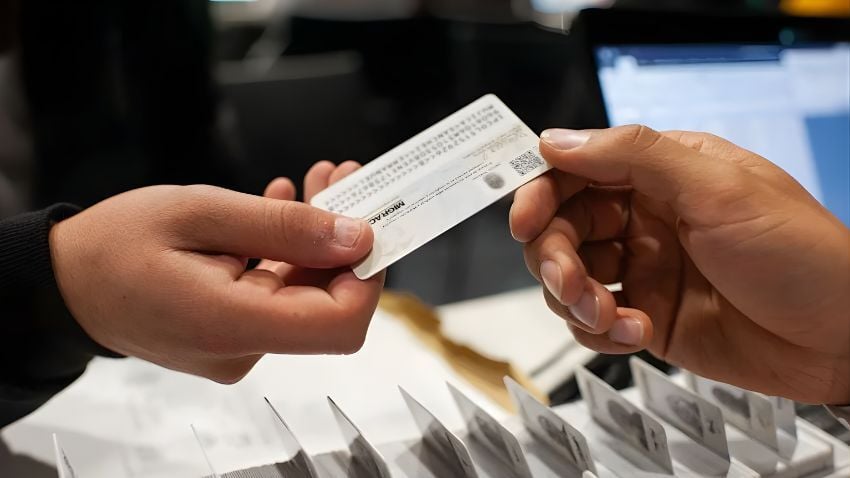The Different Types Of Residency You Need To Know
People choose the expat lifestyle for many reasons. Some seek greater personal freedom and better financial opportunities, while others want a lower...

7 min read
Could your passport be the same size as your credit card? For international travellers, a standard passport is a must-have. It’s your key to exploring new countries, visiting friends and family, researching investment opportunities, or simply going on vacation.
However, with its many pages, carrying a bulky passport every day isn’t always practical, especially for Americans living near the Mexican or Canadian borders who frequently cross for work. Luckily, there is a more convenient and cost-effective solution: the U.S. Passport Card.
In this article, you'll discover the benefits of this compact travel document, its costs, how to apply for it, and how it differs from a standard U.S. passport. Read on to find out all the details.

The U.S. passport book is among the world's strongest, granting access to many countries and essential for international travel. The passport card, however, is a special travel document for specific countries
The Passport Card is a unique travel document designed for specific travel needs. It is valid for domestic and international travel by land or sea to and from Mexico, Canada, Bermuda, and Caribbean countries. This card offers a more affordable and convenient ID option for frequent land and sea travellers between the U.S. and these destinations.
The passport book is the quintessential travel document for international travel. The American passport, in particular, grants visa-free access to multiple countries and is considered one of the strongest passports globally – though with certain tax obligations. A passport card, however, is a special travel document used for travelling to specific countries.
So, what sets the U.S. passport card apart from the passport book? Check the table below to find out:
|
Document Type: |
Passport Book |
Passport Card |
|
Travel Privileges: |
International travel by air, land, or sea |
Domestic and international travel by land or sea to or from Mexico, Canada, Caribbean states, and Bermuda |
|
Size: |
5.5 x 3.9 inches |
Same as a credit card |
|
First-Time Application Cost: |
$165 USD for adults |
$65 USD for adults |
|
Renewal Cost: |
$130 USD for adults |
$30 USD for adults |
Note that fees are non-refundable, and both documents have the same validity:
10 years for adults;
5 years for children under 16.
However, a U.S. passport card allows for faster land border crossing between the U.S. and Mexico or Canada.

The passport card is especially useful for crossing land and sea borders between the U.S. and neighbouring countries. It allows hassle-free travel to and from Mexico, Canada, Bermuda, and the Caribbean
The passport card may not be as useful for most Americans, especially considering most international travel is done by air. However, for some individuals, the passport card can come in handy.
The passport card’s compact size, similar to a credit card, can fit well into your wallet. Carrying your passport book when travelling overseas is uncomfortable, as it hardly fits your pockets and could get lost inside your bag. In contrast, a passport card is much more convenient to carry, which is beneficial if you travel by land or sea.
Another major advantage of the passport card is its affordability. The passport card is considerably cheaper than the passport book, costing $65 USD for adults and $50 USD for children under 16, compared to $165 USD and $135 USD, respectively, for the passport book. This lower cost is an appealing option for travellers who just need to visit nearby countries but do not require complete international access.
The passport card is useful for crossing borders by land and sea between the U.S. and neighbouring countries. As mentioned above, it is accepted for travel to and from Mexico, Canada, Bermuda and the Caribbean, allowing for hassle-free entry and exit. This travel document is particularly useful for individuals like:
Frequent Border Crossers: if you live near the U.S.-Canada or the U.S.-Mexico border and frequently cross for work or visiting family, the passport card is a practical tool.
Cruise Travellers: Whenever you feel like taking a cruise to Bermuda or the Caribbean, the passport card is an easy-to-carry form of identification.
Regional Travellers: The card is ideal for those who travel to the aforementioned countries for short-term stays.

We will simplify and summarize the key forms you may need to apply for or renew your passport card, making the entire process easier for you
There are different forms for applying for a passport card, and each one will suit your needs, whether it is your first time getting it or renewing it. Navigating these waters takes time, and you may be confused by the online information. We will simplify this by summarizing the main forms you may need to apply for or renew your passport card.
In this session, we will explore the three main forms for you to apply and mention the others at the end so you know there are other special case forms.
Form DS-11 is for those who apply for a passport card (or book) in person at an acceptance facility, a passport agency (by appointment only), or a U.S. embassy, consulate, or consular agency (if abroad). You must apply at any of these locations using this form if you meet at least one of the following requirements:
You apply for your first U.S. passport;
You are under 16;
Your previous passport was issued when you were under 16 years of age, issued over 15 years ago, or was simply lost, stolen or damaged.
Form DS-82 is for those who need to renew their current or recently expired passport card (or book). You can renew via mail if you meet all of the following requirements:
You must submit your most recent U.S. passport book and/or card with this application;
You were at least 16 years old when your most recent U.S. passport book and/or card was issued;
You were issued your most recent U.S. passport book and/or card less than 15 years ago;
The U.S. passport book and/or card that you are renewing has not been mutilated, damaged, or reported lost or stolen;
Your U.S. passport was not limited to less than the normal ten-year validity period due to passport damage/mutilation, multiple passport thefts/losses, or non-compliance with 22 C.F.R. 51.41. (Refer to the last page of your U.S. passport book for endorsement information);
Your name has not changed since your most recent U.S. passport book and/or card was issued. Or, your name has been changed by marriage or court order, and you can submit proper certified documentation to reflect your name change (such as a certified copy of a marriage certificate or court order).
Note that you should use Form DS-82 to apply for your first passport book if you only have a passport card or apply for your first passport card if you only have a passport book.
Form DS-5504 is for those who need corrections, have had a name change within 1 year of passport issuance, and limited passport holders. You can use this form if you meet one of the following requirements:
You have changed your name less than one year since your most recent U.S. passport book and/or U.S. passport card was issued, AND your U.S. passport book and/or U.S. passport card is less than one year old;
Your identifying information in your most recent U.S. passport book and/or U.S. passport card was printed incorrectly;
Your most recent U.S. passport book was limited to two years or less for reasons other than multiple losses or a seriously damaged/mutilated passport.
If you say “NO” to all of these statements, you cannot use this form and must resort to one of the above-mentioned forms.
We've already discussed the three main forms for your initial application or renewal. Now, let's look at the four additional forms for special cases:
DS-64: To report if your passport was lost or stolen;
DS-3053: Statement of consent for issuing a passport to a child;
DS-5525: Statement of special family circumstances;
DS-86: Statement you did not receive your U.S. passport.

Include your most recent U.S. passport book or card, issued when you were 16 or older, in your current name, and within the last 15 years. If it is mutilated, damaged, or lost, use Form DS-11 to apply
Gather Required Documents:
Attach one colour photograph (2x2 inches).
Gather proof of U.S. citizenship (e.g., birth certificate, previous passport, Certificate of Naturalization).
Provide proof of identity (e.g., driver’s license, government ID).
For applicants under 16, provide evidence of parental relationship (e.g., birth certificate).
Proof of fee payment (by check or money order). If abroad, check with your local embassy or consulate what modes of payment are accepted.
Complete The Form: After analyzing all the forms, choose the one that best suits your situation and fill it out;
Attach The Required Documents: See Step 1.
Schedule an Appointment: Visit travel.state.gov or call the National Passport Information Center (tel. 1-888-874-7793) to schedule an appointment;
Attend the Appointment: Present the completed form DS-11 and all required documents to the authorized agent. The agent will administer an oath, witness you signing the form, and collect the passport fee;
Track Your Application: Monitor the status of your application online;
Receive Your Passport Card: Your new passport card and original supporting documents will be mailed to you. Note that you may receive these items in separate mailings.
Gather Required Documents:
Your most recently issued U.S. passport book or card. When submitting a U.S. passport book and/or card with this form, ensure the document was issued when you were 16 or older, is in your current name, and was issued within the last 15 years. Include any valid passport products you have with this application. If your U.S. passport book and/or card has been mutilated, damaged, or reported lost or stolen, you must use Form DS-11 to apply;
Attach one colour photograph (2x2 inches);
Proof of name change (e.g., marriage certificate, divorce certificate) if applicable;
Proof of fee payment (by check or money order). If abroad, check with your local embassy or consulate what modes of payment are accepted.
Complete The Form: After analyzing all the forms, choose the one that best suits your situation for renewal and fill it out;
Then, depending on where you live, mail the application to one of these locations:
If you live in California, Florida, Illinois, Minnesota, New York, or Texas and require routine service, mail to the National Passport Processing Center, PO Box 640155, Irving, TX 75064-0155;
If you live in any other state or Canada and require either routine or expedited service, mail to National Passport Processing Center, PO Box 90155, Philadelphia, PA 19190-0155;
If you live somewhere other than the U.S. and Canada, refer to your local U.S. embassy or consulate for submitting and processing your application.

If you are American, my advice is to carry both your passport card and passport book, as you never know when you might need them
The U.S. passport card is a compact, cost-effective, and practical travel document for specific travel needs, especially for expats and frequent travellers. It offers a convenient alternative to the traditional passport book, providing ease of use for land and sea travel to Mexico, Canada, Bermuda, and the Caribbean.
Even though this card has fewer travel privileges than a regular passport book, it is a convenient choice whenever you want to travel to any of these countries. Whether you cross the borders daily for work or just want to cruise to a beautiful island in the Caribbean, a U.S. passport card will be useful.
If you are an American, I advise you to get both the passport book and card, as you never know when you will need them. Instead of processing them separately, you get a $35 USD discount. Imagine you travel domestically but forget your passport book at home; then, you can use your passport card inside your wallet. In conclusion, a passport card is an extra layer of security and convenience for every American, whether for qualified trips abroad or domestic travel.
If you want the best intel from the expat world, including profitable offshore opportunities, little-known tax-saving strategies, and hard-won insights on immigration, passports, and Plan-B residencies, all delivered to your inbox every single week, then join our daily correspondence, EMS Pulse®. Currently enjoyed by over 84,000 expats and expat-hopefuls worldwide. Fill in the form below to join our newsletter free:

Written by Mikkel Thorup
Mikkel Thorup is the world’s most sought-after expat consultant. He focuses on helping high-net-worth private clients to legally mitigate tax liabilities, obtain a second residency and citizenship, and assemble a portfolio of foreign investments including international real estate, timber plantations, agricultural land and other hard-money tangible assets. Mikkel is the Founder and CEO at Expat Money®, a private consulting firm started in 2017. He hosts the popular weekly podcast, the Expat Money Show, and wrote the definitive #1-Best Selling book Expat Secrets - How To Pay Zero Taxes, Live Overseas And Make Giant Piles Of Money, and his second book: Expats Guide On Moving To Mexico.
.jpg)
People choose the expat lifestyle for many reasons. Some seek greater personal freedom and better financial opportunities, while others want a lower...

Every year brings new lessons, opportunities, and milestones worth revisiting. As 2025 comes to a close, we’re taking a moment to reflect on the...

Latin America has become one of the most straightforward regions in the world for securing residency. Most countries in the region offer simple,...